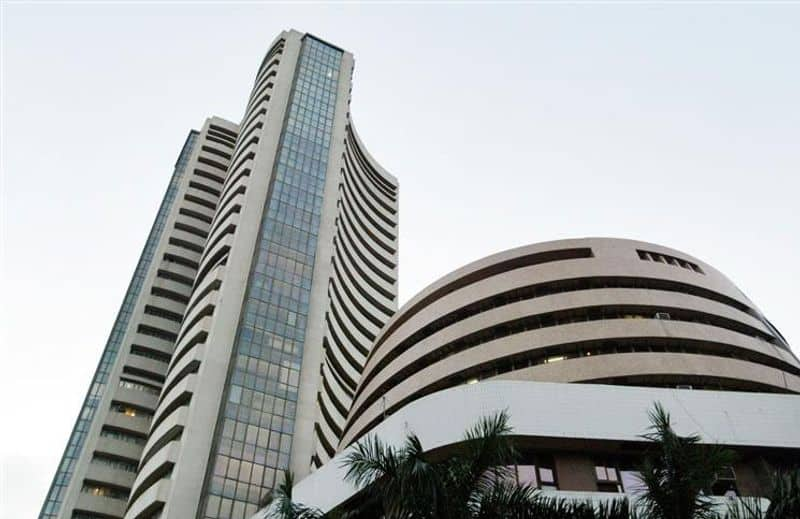Japan's Nikkei, Hong Kong's Hang Seng, Shanghai Composite Index, Korea's KOSPI, Paris CSCV 40, Frankfurt's DAX, London's FTSE, US Dow Jones Industrial Average — are all down, but the India's Sensex, Nifty BSE Infrastructure, etc are constantly rallying
Mumbai/New Delhi: On Tuesday, in a major boost to the domestic market, the Indian rupee jumped 93 paise (intra-day) to trade at 70.63 against the US dollar and the benchmark Brent crude dropped to 57.98 a barrel, a fall 2.73%, easing India's concerns on the current account deficit front.
The continuous rally in the stock market can be projected by the Narendra Modi government as an achievement of its economic policies, much as the ruling parties in India are normally wary of tom-tomming market performance as their feat. This is because the Indian market is doing particularly well despite the apprehension of a slowdown worldwide. In Asia, Japan's Nikkei fell 1.82%. Hong Kong's Hang Seng dropped 0.90%, Shanghai Composite Index fell 0.82% and Korea's KOSPI fell 0.43%. European shares too were in the negative zone in their early deals. Paris CSCV 40 fell 0.72%, while Frankfurt's DAX shed 0.30%. London's FTSE too down 0.82%. The US Dow Jones Industrial Average ended 2.11% down Monday.
"Market reversed from day's low despite weak global market as oil prices slid further and a drop in bond yield raised investors' confidence. Global market traded on a negative note due to concerns of a slowdown in world economic growth. Strong rupee and fall in yield is easing the liquidity concerns of the market," Vinod Nair, Head of Research, Geojit Financial Services Ltd, said.
Indian equity benchmarks reversed early losses to end in the green, marking their sixth consecutive gains, helped by late buying in mainly in pharma, metal and capital goods as firming rupee and sliding crude lifted investors' sentiment.
The BSE benchmark Sensex ended 77 points higher despite losses in information technology and FMCG counters amid weak global cues.
Similarly, the broader NSE Nifty edged higher by over 20 points to close above the 10,900-level.
The BSE Sensex swung almost 329 points both sides on hectic selling and buying during the session.
The 30-share index started lower at 36,226.38 and continued to slide as selling pressure gathered momentum and hit a low of 36,046.52 in line with a weak trend in Asian markets and lower opening of European shares.
However, hectic buying in late afternoon trade reversed the day's losses and helped the Sensex scale 36,375.38 before settling 77.01 points, or 0.21%, higher at 36,347.08.
The gauge had risen over 1,310 points in the last five sessions.
The 50-share NSE Nifty too rose by 20.35 points, or 0.19%, to end at 10,908.70. Intra-day, it traded between 10,819.10 and 10,915.40.
Companies doing well
Sun Pharma emerged as the best performer in the Sensex pack, surging 2.98%, followed by PowerGrid at 1.74%.
Other gainers were M&M 1.62%, Vedanta 1.58%, Asian Paints 1.47%, L&T 1.42%, SBI 1.35%, ICICI Bank 1.22%, NTPC 1.20%, Kotak Bank 1.08%, Bharti Airtel 0.91%, Tata Steel 0.76% and Maruti Suzuki 0.64%.
RIL, Hero Motocorp, Axis Bank, Tata Motors, Adani Ports, Coal India, HDFC Bank, IndusInd Bank and Bajaj Auto also showed strength and gained up to 0.62%.
Stocks of state-run oil marketing companies such as HPCL, BPCL and IOC surged up to 2.75% on the back of easing crude oil prices in the global market.
Shares of aviation companies like Spicejet and InterGlobe climbed up to 7.44%, largely supported by easing crude prices.
Among sectoral indices, the BSE infrastructure gained the most by rising 1.11%, followed by power at 1.09%, capital goods 1.09%, PSU 1.07%, metal 0.90%, auto 0.66%, healthcare 0.47%, oil and gas 0.42% and realty 0.26%.
Who all resent a strong rupee?
On the other hand, shares of software exporters such as Infosys, Wipro and TCS lost up to 2.48% due to a stronger rupee. Other losers in the Sensex were ONGC, HDFC, HUL, ITC and Yes Bank.
However, tech and IT indices emerged as the worst performers by falling up to 1.13% on account of appreciating domestic currency.
According to provisional data, domestic institutional investors sold shares worth a net of Rs 76.84 crore, while foreign institutional investors (FIIs) offloaded shares to the tune of Rs 60.95 crore Monday.
Globally, stocks slipped into the red tracking overnight sharp losses at the Wall Street as investors continued to fear weakening growth amid caution ahead of the US Federal Reserve's two-day meeting, beginning Tuesday.
The US Federal Reserve's policy decision is expected on December 19 and the market is expecting another rate hike, traders said.
Why and where Modi gets credit for the market rally
Not so long ago when the rupee was falling and the international crude price rising, the Modi government got no respite from the political commentators who had a field day ridiculing the state of the economy. Now, this is not merely a six-day phenomenon. The market has been doing better and better since November 30. "The benchmark Sensex rose 5.1 per cent in November — its steepest monthly gain since July. It climbed 0.1 per cent to 36,194.30 on Friday. The Nifty rose 4.7 per cent in the month. Overseas investors bought net Indian shares worth $720 million through November 28 after three months of selling," reported Bloomberg and Business Standard jointly on the last day of last month.
In the meantime, the rupee had once climbed down: less than 70 to a US dollar. Of course, the global crude price plummeting to $ 86 a barrel played a role. But it was neither the fall of petrol price from Rs 84 a litre in Delhi nor the cheapening of gold that made the rupee bolder. Neither was the Indian market fundamentally poor for a while to make the rupee weak. The US Fed rates were hiked thrice, and a higher Fed rate normally strengthens the dollar.
India’s $75-billion currency swap agreement with Japan allayed fears in the financial markets. The apprehension of a capital outflow receded.
While the RBI under governors Raghuram Rajan and Urjit Patel resisted rate cuts in the name of institutional autonomy, the falling crude prices eased off the prices of a whole lot of commodities, making the central bank's inflation-targeting a much less onerous job.
Now, the nature of the companies that are doing well must be noted to see what role policy plays in market fluctuations. The banks are particularly doing well in all Indian markets, showing signs of recovery from the NPA crisis.
Pharmaceuticals, metals and automobiles are doing well, too. The one-and-a-half-month old booster for the MSMEs is paying off. Easy loans, easier cash flow, interest concessions, clusters for pharmaceutical businesses, relaxation of labour laws, etc were some significant policy decisions Prime Minister Narendra Modi took on November 2, the results of which are now showing.
With inputs from PTI
Last Updated Dec 18, 2018, 9:45 PM IST











![Salman Khan sets stage on fire for Anant Ambani, Radhika Merchant pre-wedding festivities [WATCH] ATG](https://static-ai.asianetnews.com/images/01hr1hh8y86gvb4kbqgnyhc0w0/whatsapp-image-2024-03-03-at-12-24-37-pm_100x60xt.jpg)
![Pregnant Deepika Padukone dances with Ranveer Singh at Anant Ambani, Radhika Merchant pre-wedding bash [WATCH] ATG](https://static-ai.asianetnews.com/images/01hr1ffyd3nzqzgm6ba0k87vr8/whatsapp-image-2024-03-03-at-11-45-35-am_100x60xt.jpg)



